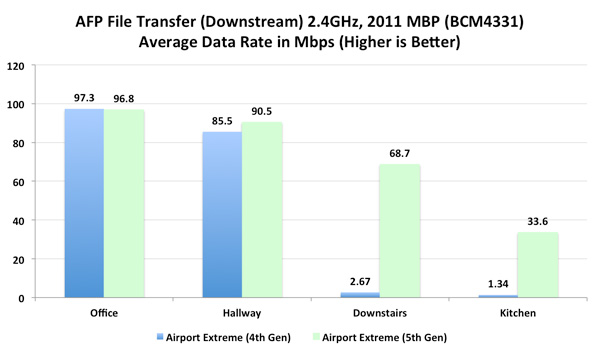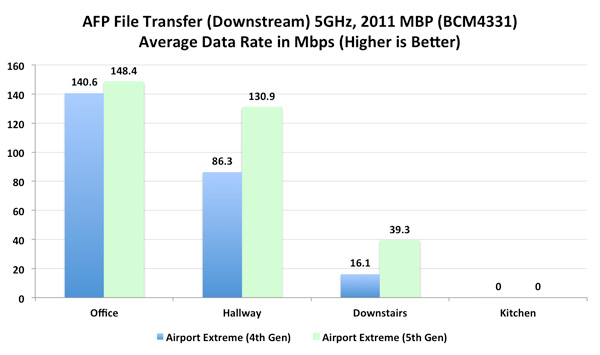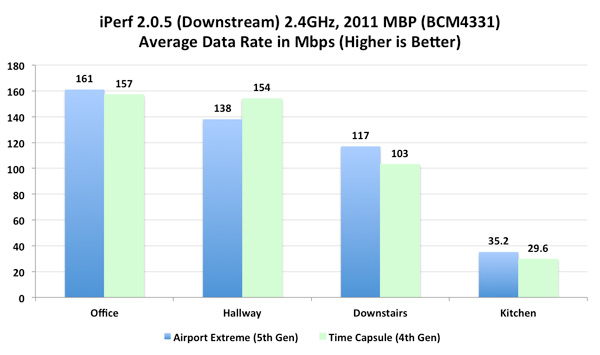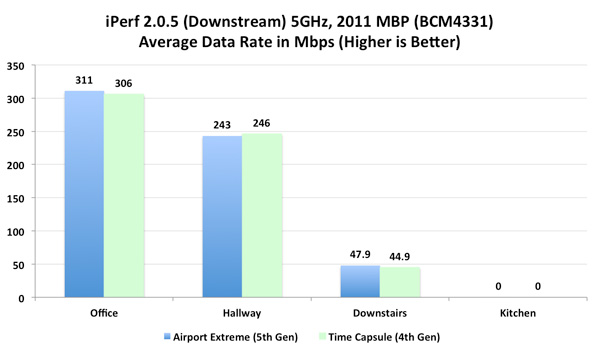Airport Extreme (5th Gen) and Time Capsule (4th Gen) Review - Faster WiFi
by Brian Klug on August 5, 2011 10:22 PM EST- Posted in
- Mac
- Airport Extreme
- Time Capsule
- WiFi
Performance Testing
Before I go any further, just a warning that this is dense, and even for me there are an almost overwhelming number of tables. I struggled with how to present data and settled on the format below, which consists of individiaual tables and a few graphs at the end in case you're a visual person. There's a third option however, which is the google docs spreadsheet I used while collecting data. I've made it public for your enjoyment and it contains the exact same data. (Update: Google Apps is acting wonky and not letting me share the spreadsheet quite yet—it will be posted in a little while. Update 2: Here we go, finally got the link to the spreadsheet for your persual)
First up is the received signal strength, which will show just how much difference that extra ~140 mW will buy. In reality, it’s surprisingly hard to see the difference, but again that increase in strength is only a few dBm, so I suppose it not being very dramatic here is to be expected since this is also a logarithmic scale. That said, the Gen 5 does post numbers correspondingly above the Gen 4 on average; remember that closer to 0 is higher power and thus better. The difference is actually more visible on 2.4GHz than 5GHz based on these numbers.
| agrCtlRSSI (dBm) Comparison—2.4GHz (Closer to 0 is Better) | |||||||||
| 2011 MacBook Pro (BCM4331,3x3:3) |
2010 MacBook Pro (BCM4322,2x2:2) |
||||||||
| Apple Airport Extreme | 4th Gen | 5th Gen | 4th Gen | 5th Gen | |||||
| Office (1) | -46 | -44 | -45 | -40 | |||||
| Hallway (2) | -52 | -50 | -52 | -52 | |||||
| Downstairs (3) | -71 | -70 | -77 | -77 | |||||
| Kitchen (4) | -84 | -81 | -85 | -84 | |||||
| agrCtlRSSI (dBm) Comparison—5GHz (Closer to 0 is Better) | |||||||||
| 2011 MacBook Pro (BCM4331,3x3:3) |
2010 MacBook Pro (BCM4322,2x2:2) |
||||||||
| Apple Airport Extreme | 4th Gen | 5th Gen | 4th Gen | 5th Gen | |||||
| Office (1) | -47 | -48 | -44 | -47 | |||||
| Hallway (2) | -59 | -60 | -54 | -52 | |||||
| Downstairs (3) | -81 | -81 | -82 | -81 | |||||
| Kitchen (4) | N/A | N/A | N/A | N/A | |||||
Next is MCS (Modulation Coding Scheme) which shows how fast the card is connecting to the 802.11n network. Here we can see how much the 5th generation airport extreme improves MCS selection in a number of cases, especially the three spatial stream scenarios on the 2011 MacBook Pro.
| MCS Comparison—2.4GHz (Higher is Better) | |||||||||
| 2011 MacBook Pro (BCM4331,3x3:3) |
2010 MacBook Pro (BCM4322,2x2:2) |
Lenovo X300 (Intel 6300 3x3:3) |
|||||||
| Apple Airport Extreme | 4th Gen | 5th Gen | 4th Gen | 5th Gen | 4th Gen | 5th Gen | |||
| Office (1) | 22 | 23 | 14 | 15 | 23 | 23 | |||
| Hallway (2) | 11 | 22 | 13 | 15 | 22 | 22 | |||
| Downstairs (3) | 4 | 12 | 0 | 11 | 21 | 13 | |||
| Kitchen (4) | 0 | 8 | 0 | 9 | 5 | 12 | |||
| MCS Comparison—5GHz (Higher is Better) | |||||||||
| 2011 MacBook Pro (BCM4331,3x3:3) |
2010 MacBook Pro (BCM4322,2x2:2) |
Lenovo X300 (Intel 6300 3x3:3) |
|||||||
| Apple Airport Extreme | 4th Gen | 5th Gen | 4th Gen | 5th Gen | 4th Gen | 5th Gen | |||
| Office (1) | 23 | 23 | 15 | 15 | 23 | 23 | |||
| Hallway (2) | 21 | 22 | 15 | 14 | 12 | 22 | |||
| Downstairs (3) | 1 | 9 | 1 | 2 | 5 | 5 | |||
| Kitchen (4) | N/A | N/A | N/A | N/A | 3 | 3 | |||
Locations 3 and 4, which are in challenging environments, see massive increases, previously going from the lowest possible (or not even 802.11n) rate up to much faster rates on both MacBooks.
AFS is our next test, where we transfer a 500MB zip file up and down from an AFS server and average the throughput. On the downstream side of things, the improvements aren’t substantial until we’re in a challenging RF scenario downstairs;, here the new generation wireless card in the Airport Extreme makes a huge difference in throughput on 2.4GHz, and similarly on 5GHz, though at the farthest location it’s still impossible to connect to 5GHz.
| AFS File Transfer Performance (Downstream)—2.4GHz (Mbps—Higher is Better) | |||||||||
| 2011 MacBook Pro (BCM4331,3x3:3) |
2010 MacBook Pro (BCM4322,2x2:2) |
||||||||
| Apple Airport Extreme | 4th Gen | 5th Gen | 4th Gen | 5th Gen | |||||
| Office (1) | 97.3 | 96.8 | 64.2 | 76.6 | |||||
| Hallway (2) | 85.5 | 90.5 | 65.3 | 71.8 | |||||
| Downstairs (3) | 2.67 | 68.7 | 2.1 | 39.4 | |||||
| Kitchen (4) | 1.34 | 33.6 | N/A | 16.5 | |||||
| AFS File Transfer Performance (Downstream)—5GHz (Mbps—Higher is Better) | |||||||||
| 2011 MacBook Pro (BCM4331,3x3:3) |
2010 MacBook Pro (BCM4322,2x2:2) |
||||||||
| Apple Airport Extreme | 4th Gen | 5th Gen | 4th Gen | 5th Gen | |||||
| Office (1) | 140.6 | 148.4 | 95.3 | 122.9 | |||||
| Hallway (2) | 86.3 | 130.9 | 84.9 | 99.5 | |||||
| Downstairs (3) | 16.1 | 39.3 | 6.6 | 19.5 | |||||
| Kitchen (4) | N/A | N/A | N/A | N/A | |||||
When it comes to upstream, the results are dramatic both on 2.4GHz and 5GHz. Throughput is almost always over double, thanks probably in part to the better front end and receive sensitivity of the Airport Extreme’s new wireless stack.
| AFS File Transfer Performance (Upstream)—2.4GHz (Mbps—Higher is Better) | |||||||||
| 2011 MacBook Pro (BCM4331,3x3:3) |
2010 MacBook Pro (BCM4322,2x2:2) |
||||||||
| Apple Airport Extreme | 4th Gen | 5th Gen | 4th Gen | 5th Gen | |||||
| Office (1) | 54.0 | 128.6 | 52.6 | 81.5 | |||||
| Hallway (2) | 45.3 | 105.1 | 30.9 | 78.1 | |||||
| Downstairs (3) | 4.0 | 37.6 | 2.8 | 32.7 | |||||
| Kitchen (4) | N/A | 10.5 | N/A | 15.3 | |||||
| AFS File Transfer Performance (Upstream)—5GHz (Mbps—Higher is Better) | |||||||||
| 2011 MacBook Pro (BCM4331,3x3:3) |
2010 MacBook Pro (BCM4322,2x2:2) |
||||||||
| Apple Airport Extreme | 4th Gen | 5th Gen | 4th Gen | 5th Gen | |||||
| Office (1) | 186.7 | 214.5 | 150 | 134.2 | |||||
| Hallway (2) | 175.2 | 195.8 | 145.7 | 119.5 | |||||
| Downstairs (3) | 19.8 | 34.3 | 11.6 | 21.6 | |||||
| Kitchen (4) | N/A | N/A | N/A | N/A | |||||
Iperf is finally up, which we can run on the X300 in addition to both Macs. Here on downstream the results are improved pretty substantially for the 3x3:3 2011 MacBook Pro, and across the board for the challenging downstairs RF scenarios. The same applies on 5GHz as well, and in the best case, we can push nearly 300 Mbps on the new MacBook Pro. It’s a dramatic improvement in best case throughput if you have the right card, though the Intel card ends up performing similarly on 5GHz with both the new and old Airport Extreme card. More on that in a second.
| iperf 2.0.5 (Downstream)—2.4GHz (Mbps—Higher is Better) | |||||||||
| 2011 MacBook Pro (BCM4331,3x3:3) |
2010 MacBook Pro (BCM4322,2x2:2) |
Lenovo X300 (Intel 6300 3x3:3) |
|||||||
| Apple Airport Extreme | 4th Gen | 5th Gen | 4th Gen | 5th Gen | 4th Gen | 5th Gen | |||
| Office (1) | 112 | 161 | 71.9 | 87.4 | 88.3 | 84.8 | |||
| Hallway (2) | 91.7 | 138 | 69.1 | 78.1 | 75.8 | 84.7 | |||
| Downstairs (3) | 5.89 | 117 | 2.22 | 46.9 | 51.9 | 68.7 | |||
| Kitchen (4) | 1.49 | 35.2 | N/A | 23.7 | 14.4 | 46.1 | |||
| iperf 2.0.5 (Downstream)—5GHz (Mbps—Higher is Better) | |||||||||
| 2011 MacBook Pro (BCM4331,3x3:3) |
2010 MacBook Pro (BCM4322,2x2:2) |
Lenovo X300 (Intel 6300 3x3:3) |
|||||||
| Apple Airport Extreme | 4th Gen | 5th Gen | 4th Gen | 5th Gen | 4th Gen | 5th Gen | |||
| Office (1) | 213 | 311 | 92.2 | 136 | 101 | 112 | |||
| Hallway (2) | 119 | 243 | 95.4 | 97.2 | 98 | 106 | |||
| Downstairs (3) | 17.5 | 47.9 | 6.83 | 21.3 | 41.5 | 57.5 | |||
| Kitchen (4) | N/A | N/A | N/A | N/A | 13.8 | 11.1 | |||
On the upstream with Iperf things improve dramatically across the board on 2.4GHz, and marginally improve on 5GHz with the new WLAN card inside the Airport Extreme.
| iperf 2.0.5 (Upstream)—2.4GHz (Mbps—Higher is Better) | |||||||||
| 2011 MacBook Pro (BCM4331,3x3:3) |
2010 MacBook Pro (BCM4322,2x2:2) |
Lenovo X300 (Intel 6300 3x3:3) |
|||||||
| Apple Airport Extreme | 4th Gen | 5th Gen | 4th Gen | 5th Gen | 4th Gen | 5th Gen | |||
| Office (1) | 57.7 | 159 | 64.2 | 97.7 | 65.1 | 126 | |||
| Hallway (2) | 33.1 | 120 | 24 | 98.4 | 42.3 | 113 | |||
| Downstairs (3) | 4.42 | 36.7 | 4.26 | 33.6 | 20.6 | 38.4 | |||
| Kitchen (4) | 1.89 | 11.6 | 1.50 | 8.51 | 7.39 | 21.1 | |||
| iperf 2.0.5 (Upstream)—5GHz (Mbps—Higher is Better) | |||||||||
| 2011 MacBook Pro (BCM4331,3x3:3) |
2010 MacBook Pro (BCM4322,2x2:2) |
Lenovo X300 (Intel 6300 3x3:3) |
|||||||
| Apple Airport Extreme | 4th Gen | 5th Gen | 4th Gen | 5th Gen | 4th Gen | 5th Gen | |||
| Office (1) | 215 | 302 | 168 | 191 | 154 | 148 | |||
| Hallway (2) | 196 | 252 | 169 | 174 | 150 | 144 | |||
| Downstairs (3) | 15.4 | 41 | 7.97 | 22.9 | 26.8 | 39.4 | |||
| Kitchen (4) | N/A | N/A | N/A | N/A | 7.55 | 8.66 | |||
At the end of the day, the new Airport Extreme dramatically improves throughput in the best case and in a few regions where signal was previously unusable. In the worst case (location 4), performance improves from being essentially unusable to totally fine, and in the case of the 2010MBP goes from not being able to connect at all to pushing 23 Mbps.
So the unanswered question is how the 3x3:3 2011MBP manages to be much faster compared to the 3x3:3 Intel 6300 card, and I suspect the answer might be that the combination of BCM4331 on the client and BCM4331 on the AP enables Apple to use Broadcom’s frame bursting high speed modes—aka modern speedbooster. Careful observers will note in addition that while Iperf over 40 MHz 802.11n (with a link rate of 450 Mbps) delivers 311 Mbps of downstream, the same test on AFS is around 150 Mbps down, possibly due to compression. In addition, note how the Intel card lags behind in locations 1 and 2 until signal gets lower and then becomes competitive again. To me, this definitely seems to indicate some Broadcom-to-Broadcom enhancements are at play. Frankly for Apple this makes sense considering their top to bottom ecosystem control; if you have the ability to choose the card in the AP and the client, why not go with a solution that offers benefits?
Airport Extreme vs. Time Capsule
The next question is how the Time Capsule compares. Rather than re-run all 128 data-points (and then multiple tests per scenario for the purposes of averaging and removing outliers), I decided to use a subset and see whether performance and range is the same on the Time Capsule in those cases. As we showed before, the Time Capsule and Airport Extreme use the same exact wireless card, though gain is different on the Time Capsule antennas than the Airport Extreme.
For this testing, I just used the 2011MBP with its 3x3:3 radio, and ran through signal measurements and Iperf. First up is how signal strength looks.
| agrCtlRSSI (dBm) Comparison (Closer to 0 is Better) | |||||||||
| 2.4GHz | 5GHz | ||||||||
| Airport Extreme | Time Capsule | Airport Extreme | Time Capsule | ||||||
| Office (1) | -44 | -41 | -48 | -49 | |||||
| Hallway (2) | -50 | -51 | -60 | -60 | |||||
| Downstairs (3) | -70 | -68 | -81 | -83 | |||||
| Kitchen (4) | -81 | -81 | N/A | N/A | |||||
You can pretty much immediately tell that things are very similar. On 2.4GHz and 5GHz the two are very comparable except in a few odd cases. Of course the propagation isn’t going to be identical between the two, but subjectively it’s close.
Next is MCS, and here things are again close, with the Time Capsule narrowly edging out the Airport Extreme on 2.4GHz, and things being very equal on 5GHz. It’s looking the same so far.
| MCS Comparison (Higher is Better) | |||||||||
| 2.4GHz | 5GHz | ||||||||
| Airport Extreme | Time Capsule | Airport Extreme | Time Capsule | ||||||
| Office (1) | 23 | 23 | 23 | 23 | |||||
| Hallway (2) | 22 | 23 | 22 | 23 | |||||
| Downstairs (3) | 12 | 13 | 9 | 8 | |||||
| Kitchen (4) | 8 | 9 | N/A | N/A | |||||
So what about performance now with Iperf? On the downstream side of things, the Airport Extreme comes out on top narrowly in all but the second location on 2.4 and 5GHz. But the difference is minuscule.
| iperf 2.0.5 (Downstream) (Mbps—Higher is Better) | |||||||||
| 2.4GHz | 5GHz | ||||||||
| Airport Extreme | Time Capsule | Airport Extreme | Time Capsule | ||||||
| Office (1) | 161 | 157 | 311 | 306 | |||||
| Hallway (2) | 138 | 154 | 243 | 246 | |||||
| Downstairs (3) | 117 | 103 | 47.9 | 44.9 | |||||
| Kitchen (4) | 35.2 | 29.6 | N/A | N/A | |||||
Upstream is a similar story, with the two being very close outside locations 3 and 4, where the Time Capsule narrowly edges the Airport Extreme out on 2.4GHz.
| iperf 2.0.5 (Upstream) (Mbps—Higher is Better) | |||||||||
| 2.4GHz | 5GHz | ||||||||
| Airport Extreme | Time Capsule | Airport Extreme | Time Capsule | ||||||
| Office (1) | 159 | 153 | 302 | 304 | |||||
| Hallway (2) | 120 | 129 | 252 | 251 | |||||
| Downstairs (3) | 36.7 | 55.5 | 41 | 32.1 | |||||
| Kitchen (4) | 11.6 | 17.3 | N/A | N/A | |||||
All said and done however, the two are incredibly close and despite the difference in gain that the FCC docs would lead you to believe, are virtually indistinguishable in some real-world testing. In my mind, if you’re concerned about WiFi performance, the Time Capsule and Airport Extreme both perform equally well.
Graphs
If you're a more visual person and find that wall of tables and text too daunting, Anand also made some awesome graphs which I would be remiss to not reproduce here for your viewing pleasure.
First up is AFS performance compared on the 2011MBP between the 4th and 5th generation Airport Extreme.














90 Comments
View All Comments
bigrobsf - Friday, August 5, 2011 - link
Minor typo in AFS discussion paragraph in the "WiFi Throughput and Range - Improved page:"Airport Extreme makes a hue difference"
I'm guessing you wanted to write "huge" :-)
Brian Klug - Saturday, August 6, 2011 - link
Good catch, thanks, should be fixed!-Brian
iwod - Saturday, August 6, 2011 - link
I just wish they put out a Raid 1 2.5" HDD Time Capsule so i know my data is going to fairly safe. HDD failure are happening more often these days and with their huge capacity i just cant afford to lose some of my content.repoman27 - Saturday, August 6, 2011 - link
Just use one of these: http://www.icydock.com/goods.php?id=121Combine with a brace of Western Digital WD10JPVT or Samsung Spinpoint M8 HN-M101MBB and you'll have 1 TB of RAID 1 goodness.
Penti - Sunday, August 7, 2011 - link
Raid 1 doesn't really protect from bit rot, just pure 1 drive failure. However they should take reliability and data corruption seriously, but it's not enterprise hardware so you can't really expect it.jackwong - Sunday, August 14, 2011 - link
I will never go with TC unless they have a better backup solution of the TC itself.I have a Synology 1 bay NAS with a external USB to backup all the contents on it.
cheinonen - Saturday, August 6, 2011 - link
Though I imagine most people won't be confused, labeling it as "Smaller values are better" when all the values are negative could cause people to read the data incorrectly. Perhaps "Closer to 0 is better" or something else?Brian Klug - Saturday, August 6, 2011 - link
Totally agreed, edited those tables to make it more easy to follow.-Brian
jigglywiggly - Saturday, August 6, 2011 - link
time capsule wins an award for stealing your money.500$ for a wireless 3tb hd? Don't be sodding st00pid.
repoman27 - Saturday, August 6, 2011 - link
$300 for a $150 simultaneous dual-band, three-stream router with gigabit switch, on board SATA controller and an $80 HD, all in one compact little unit along with the PSU? Not a bad deal, really.Paying $200 (2/3) more for a $70 HD upgrade that only provides 50% more storage space? Questionable, but Apple knows that most people won't bother to upgrade themselves because they'd be out of pocket an additional $150 for the drive and then have to open a brand new device to make the swap.